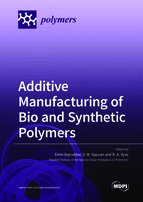Additive Manufacturing of Bio and Synthetic Polymers
A special issue of Polymers (ISSN 2073-4360). This special issue belongs to the section "Polymer Processing and Engineering".
Deadline for manuscript submissions: closed (31 July 2021) | Viewed by 76801
Special Issue Editors
Interests: advanced manufacturing processes (sinter forging, thixoforming); damage mechanisms of materials (metallic, intermetallic, rubber and epoxy-based composites); design of new composites and damage characterization; design and manufacturing of recycled constituent composites
Special Issues, Collections and Topics in MDPI journals
Interests: natural fibre composites; material selection; biobased packaging
Special Issues, Collections and Topics in MDPI journals
2. Centre for Advanced Composite Materials, Universiti Teknologi Malaysia, 81310 UTM Johor Bahru, Johor, Malaysia
Interests: polymer engineering; material engineering; natural fibres; nanocellulose; biopolymer; biodegradable polymer; biocomposites and nanocomposites
Special Issues, Collections and Topics in MDPI journals
Special Issue Information
Dear Colleagues,
Additive (manufacturing) technology offers the ability to produce personalized products with lower development costs, shorter lead times, less energy consumed during manufacturing and less material waste. It can be used to manufacture complex parts, and enables manufacturers to reduce inventory, make products on-demand, create smaller localized manufacturing environments, and even reduce supply chains. Additive manufacturing (AM), also known as fabricating three-dimensional (3D) and four-dimensional (4D) components, refers to processes that allow for the direct fabrication of physical products from computer-aided design (CAD) models through the repetitious deposition of materials layers. Compared with traditional manufacturing processes, AM allows the production of customized parts from bio and synthetic polymers without the need for molds or machining typical for conventional formative and subtractive fabrication.
Today, AM offers numerous advantages, i.e., little assembly required, supply chain efficiencies, sustainability, geometric flexibility, low buy-to-fly ratio, shortened time-to-market, environmental, and in the production of single and multiple components, offering incomparable design independence with the facility to manufacture components from various bio and synthetic polymers. These advantages make AM a major player in the next polymer industrial revolution. Polymers and their composites are one of the most widely used materials in today’s industry and are of great interest in AM due to the vast potential for various applications, such as in the apparel, art and jewelry, electric and electronic, healthcare, biomedical, robotics, military defense, sensor and actuators, construction, aerospace and automotive industries. Polymers that are utilized in AM include hydrogels, elastomers, thermosets, thermoplastics, functional polymers, polymer composites, polymer hybrid composites, polymer nanocomposites and polymer blends. Over the past 30 years, much research has been done on developing new polymeric materials for AM processes, such as material jetting (MJ), drop on demand (DOD), sand binder jetting, vat photopolymerization, fused deposition modeling (FDM), stereolithography (SLA), digital light processing (DLP), and selective laser sintering (SLS).
In this Special Issue, we aim to capture the cutting-edge of the state-of-the-art in research pertaining to advancing additive manufacturing of polymeric materials. The topic themes include advanced polymeric materials development, processing parameter optimization, characterization techniques, structure–property relationships, process modelling, etc., specifically for AM.
Prof. Dr. Emin Bayraktar
Prof. Dr. S. M. Sapuan
Dr. R.A. Ilyas
Guest Editors
Manuscript Submission Information
Manuscripts should be submitted online at www.mdpi.com by registering and logging in to this website. Once you are registered, click here to go to the submission form. Manuscripts can be submitted until the deadline. All submissions that pass pre-check are peer-reviewed. Accepted papers will be published continuously in the journal (as soon as accepted) and will be listed together on the special issue website. Research articles, review articles as well as short communications are invited. For planned papers, a title and short abstract (about 100 words) can be sent to the Editorial Office for announcement on this website.
Submitted manuscripts should not have been published previously, nor be under consideration for publication elsewhere (except conference proceedings papers). All manuscripts are thoroughly refereed through a single-blind peer-review process. A guide for authors and other relevant information for submission of manuscripts is available on the Instructions for Authors page. Polymers is an international peer-reviewed open access semimonthly journal published by MDPI.
Please visit the Instructions for Authors page before submitting a manuscript. The Article Processing Charge (APC) for publication in this open access journal is 2700 CHF (Swiss Francs). Submitted papers should be well formatted and use good English. Authors may use MDPI's English editing service prior to publication or during author revisions.
Keywords
- Additive manufacturing
- 4D printin
- 3D printing
- Biopolymeric materials
- Synthetic polymeric materials









